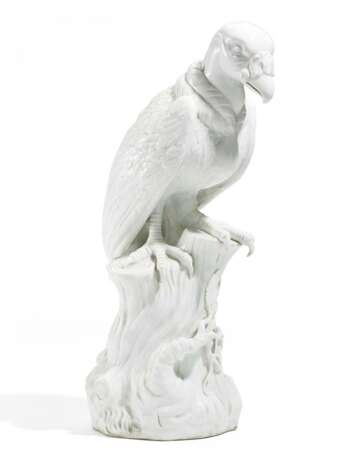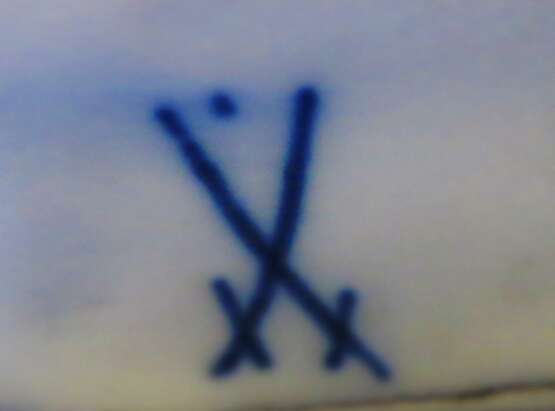ID 252359
Lot 13 | Großer stehender Königsgeier
Estimate value
€ 8 000 – 10 000
Porzellan, weiß. Der große, auf einem Baumstamm stehende Königsgeier, passt von den Maßen zu zwei Einträgen der Inventare des Japanischen Palais von 1770 und 1790. Dort heißt es: "Krob Vogel bunt gemalt auf hohen Postament mit Laubwerck belegt, schadhafft, 1 Elle 6 Zoll hoch"
. Höhe 73cm.
Pfeiffermarke, 122, Bossierernr. 37, 141. Zustand A.
Provenienz:
Hessische Privatsammlung.
Literatur:
- Pietsch, Ulrich: Meißner Porzellanplastik von Gottlieb Kirchner und Johann Joachim Kaendler, München 2006, zu Geier vgl. S. 135, Katalog-Nr. 194.
- Eikelmann, Renate (Herausgabe): Meißener Porzellan des 18. Jahrhunderts - Die Stiftung Ernst Schneider in Schloß Lustheim, München 2004, S. 374.
- Sponsel, Jean Louis: Kabinettstücke der Meissner Porzellanmanufaktur von Johann Joachim Kändler, Leipzig 1900, S. 6, 8, 14, 65, 82, 89.
- Schnorr von Carolsfeld, Ludwig: Porzellan der europäischen Fabriken des 18. Jahrhunderts, Berlin 1912, S. 53.
Den europaweiten Ruhm, den Dresden als Zentrum höfischer Prachtentfaltung im 18. Jahrhundert genoss, verdankte die Stadt Kurfürst Friedrich August I. (1670-1733). "August der Starke" hegte eine ausgeprägte Sammelleidenschaft und war nicht nur Mäzen und Liebhaber der Künste, sondern ebenso ein begeisterter Förderer der Wissenschaft. Sein Naturalienkabinett galt als die bedeutendste Sammlung ihrer Art in Europa und beinhaltete eine große Anzahl an exotischen Tieren. Er finanzierte Expeditionen, von denen die Forscher die "möglichsten Arten derer Thiere lebendig oder in Häuten und Esgwelletten (Skeletten) oder auch gemahlet" mit nach Dresden bringen sollten. Johann Joachim Kändler stand diese umfangreiche Sammlung an teilweise lebendigen Exponaten zur Verfügung, als er mit dem Entwurf lebensgroßer Tierplastiken für das "Japanische Palais" beauftragt wurde.
Das 1715 von Matthias Daniel Pöppelmann für den Grafen Flemming erbaute Palais wurde 1717 vom Kurfürsten erworben, da die Anzahl seiner Sammlungen und das Ausmaß höfischer Festivitäten nach mehr Raum verlangten. Der Entschluss, die rasch wachsende Sammlung asiatischer Porzellane im Palais unterzubringen, wurde zwei Jahre später gefasst. Bald erwog man auch die Möglichkeit, Erzeugnisse der zunehmend erfolgreichen Meissner Manufaktur dort auszustellen. Ein Plan, der bei der Prunkliebe des Kurfürsten bald Ausmaße annahm, die eine Erweiterung der Anlage erforderten. Die Planung umfasste neben der Unterbringung der bestehenden Sammlung auch die Anfertigung neuer, besonderer Kabinettstücke - in einem Umfang der, neben Johann Gottlieb Kirchner, die Anstellung eines weiteren Modelleurs notwendig machte. 1731 fiel die Wahl Augusts des Starken auf Johann Joachim Kaendler, dem es rasch gelang, sein außerordentliches Talent für den Werkstoff Porzellan unter Beweis zu stellen.
Der deutsche Schriftsteller Johann Georg Keyßler (1693-1743) beschreibt in einem Reisebericht aus dem Jahr 1740 die Pläne für das neue Japanische Palais. Dort heißt es: "In die Zimmer des obersten Stockwerkes [...] kommt kein anderes als Meissnisches Porzellan [...]. Es wird solches mit allerhand sowohl einheimischen, als ausländischen Vögeln und Thieren von purem Porzellan, in ihrer natürlichen Grösse und Farben meubliert, und kann man an denjenigen Stücken, welche schon fertig sind, die Kunst und Schönheit nicht genug bewundern."
Die außerordentliche Qualität der Tierplastiken ist bemerkenswert, insbesondere weil es sich bei ihnen um Kaendlers erste Arbeiten für die Manufaktur handelte. Sein besonderes Talent lag darin, einen charakteristischen Moment in der Bewegung des Tieres einzufangen und diesen naturalistisch wiederzugeben, was den Plastiken eine außerordentliche Lebendigkeit verleiht
| Manufactur: | Meissen Porcelain Factory |
|---|---|
| Auction house category: | Porcelain |
| Manufactur: | Meissen Porcelain Factory |
|---|---|
| Auction house category: | Porcelain |
| Address of auction |
VAN HAM Kunstauktionen GmbH Hitzelerstr. 2 50968 Köln Germany | ||||||||||||||
|---|---|---|---|---|---|---|---|---|---|---|---|---|---|---|---|
| Preview |
| ||||||||||||||
| Phone | +49 221 92586215 | ||||||||||||||
| Fax | +49 221 92 58 62 4 | ||||||||||||||
| Buyer Premium | 32% | ||||||||||||||
| Conditions of purchase | Conditions of purchase | ||||||||||||||
| Business hours | Business hours
|




